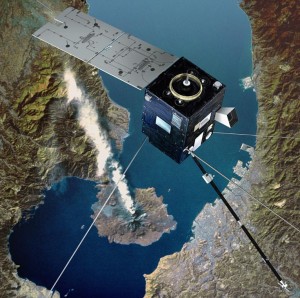10 December 2013
Hey, it’s weird up here – there must be an earthquake in the atmosphere
Months before the devastating earthquake that struck Haiti in 2010, warning signs could be detected hundreds of miles above the Earth’s surface, according to new data presented Monday at the American Geophysical Union’s Fall Meeting.
There were strange disturbances in a layer of the atmosphere called the ionosphere up to one month before the magnitude 7.0 earthquake struck about 10 miles southwest of Port-au-Prince, according to Pierre-Richard Cornely, an atmospheric scientist at Eastern Nazarene College.
Cornely used data from DEMETER, a low-orbiting satellite launched by the Centre National d’Etudes Spatiales in 2004. He compared measurements of the ionosphere from DEMETER with a predictive model, and found that in the months before the earthquake there was higher activity in the ionosphere than what would be predicted for that time and location. He presented his findings in a poster session Monday.
The ionosphere is a segment of the Earth’s atmosphere that spans approximately 50 to 370 miles above the planet’s surface. Atoms and molecules floating in that layer become ionized, or electrically charged, by radiation from the sun.
Scientists have been experimenting with a model for predicting earthquakes through ionosphere disturbances in the last few years. Though the mechanism is not clear, it seems that seismic activity in the months, days, and even hours before an earthquake causes changes in the density of charged particles in the ionosphere. Cornely believes that similar to how magnets will warp the image on a television screen, seismic activity causes shifts in electromagnetic fields that push around ions in the ionosphere.
There is still a lot of debate about how this data can be used to predict earthquakes. Seismic activity is not the only thing that disrupts the ionosphere. Sunspots and changes in the strength of Earth’s magnetic field can affect the ionosphere in ways that look similar to the changes preceding an earthquake.
Cornely, who is from Haiti, also looked at metrics from sunspot and magnetic field data around the time of the earthquake but did not find any correlation with the change in ionosphere activity. The only event during that time that corresponded to the disturbances in the ionosphere was the earthquake, he said.
Typically, changes in the ionosphere can predict only extremely large earthquakes in the hours before they strike. But if smaller earthquakes can be detected months in advance, pre-emptive measures to quell the damage could be taken.
Predicting earthquakes with disturbances in the ionosphere “is very new science,” said Cornely. “I wanted to see if there was any truth to this and go back and model it.”
– Cynthia McKelvey is a science communication graduate student at UC Santa Cruz




 GeoSpace is a blog on Earth and space science, managed by AGU’s Public Information staff. The blog features posts by AGU writers and guest contributors on all sorts of relevant science topics, but with a focus on new research and geo and space sciences-related stories that are currently in the news.
GeoSpace is a blog on Earth and space science, managed by AGU’s Public Information staff. The blog features posts by AGU writers and guest contributors on all sorts of relevant science topics, but with a focus on new research and geo and space sciences-related stories that are currently in the news.